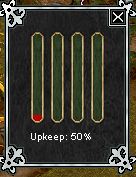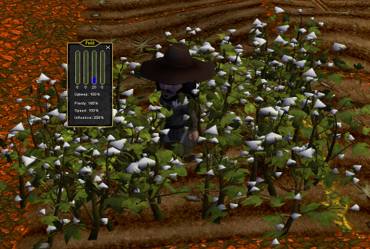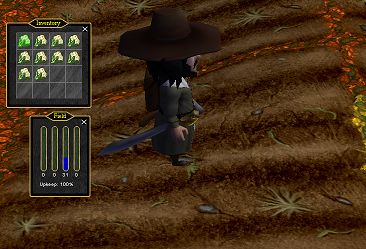Difference between revisions of "Agriculture"
m (→Seeds:: codefix and visual) |
Alexispres (talk | contribs) |
||
| Line 25: | Line 25: | ||
Hint to fill [[Compost Bin]]: | Hint to fill [[Compost Bin]]: | ||
| − | Deers provide a lots of organics ( | + | Deers provide a lots of organics (Meat shreds and especially steaks which gives 8/100 points to bin). Find deer and start battle. Bring him alive to bin and only then kill. 70 point per deer. |
Leftover seeds or lower purity seeds can also be used. 100 seeds provide 20/100. | Leftover seeds or lower purity seeds can also be used. 100 seeds provide 20/100. | ||
Revision as of 01:32, 8 July 2012
Agriculture allows one to use the "Till Field" action under the Build menu. A tilled field is required to plant any seeds.
Farming:
Farming is accomplished by the general task of tilling a field, preparing it with Humus, and then planting seeds. Once seeds are planted, you can then fertilize the fields using various items. After a period of time, your crops grow and you can then harvest them. Currently, Cabbage, Cereals, and Cotton seeds available for sale in Boston. Pumpkin seeds can be obtained through Gardening.
Preparing the field for planting requires a base of 5 Humus. After the first planting, a fields upkeep can be improved (see Fertilizers below). Setting up the very first fields for a new character takes some forethought. Humus is slow to produce in a single Compost Bin, so it is recommended two or more are built to start. (Humus is a good fertilizer and a player will go through a lot of it once farming gets underway.)
Hint to fill Compost Bin: Deers provide a lots of organics (Meat shreds and especially steaks which gives 8/100 points to bin). Find deer and start battle. Bring him alive to bin and only then kill. 70 point per deer. Leftover seeds or lower purity seeds can also be used. 100 seeds provide 20/100.
After the fields are prepared, the seeds can be planted. Each field requires an amount of seed depending on the crop planted. Having improved upkeep on the field lowers the number of seeds needed. Cotton and Grain fields require 50 seeds; Cabbage requires 15 seeds.
Once the seeds are planted, the fields can be fertilized at will up until the crops are fully grown. The only caution when using fertilizer is to avoid using +speed fertilizers late in the cycle. There is almost no return for getting a few extra percentage to the speed when there might only be a few hours left for the field to grow.
Finally, when the crops are fully grown, they can be harvested. Note that in the section on pumpkins that they can be harvested at any time once they start growing (in other words, they've grown at least one stage after planting).
Crop Growth and Rotation:
In this image, the 0th meter has about 5%. The other meters are empty.
The upkeep has been reduced to 50%, meaning 50% less humus and seed will be required to replant this field.
From Jorb (Brother Bean@Paradox/Beanieman@SynIRC.net#Salem):
"The crops use the following meters:
takes from -> gives to
(Red) Cabbage: 2,3 -> 0
(Green) Cereals: 3,0 -> 1
(Blue) Cotton: 0,1 -> 2
{Red} Pumpkin: 1,2 -> 3
The idea here is obviously that you need to rotate your crops over your various fields, and fertilize them in an intelligent manner, in order to build up their meters and thus reach the higher output tiers. For example to reach higher tier of cereal you would need to build up meters it takes from 3 and 0, so you might rotate cabbage and cotton beforehand."
From Loftar: Currently, each cycle depletes 5% (unmodified) of the elements that the crop consumes, and fills 5% (modified by the influence boost) of the meter that the crop adds to. The harvest yields tier 1 output when the sum of the two meters it consumes is 0%-50% (of one meter), a mix of tier 1 and one of the 2nd tiers when the sum is 50%-100%, a mix of the 2nd tiers when the sum is 100%-150% and a mix of one of the 2nd tiers and tier 3 when the sum is 150%-200%. I'm open to changes on that, though.
Note: There is currently a possible bug where all crops actually drain 5% from every meter besides the one it contributes to. So for example, instead of Cabbage draining 5% from only the 3rd and 4th meters, it also drains 5% from the 2nd meter as well. The amount it contributes to the meter it produces output to seems unchanged.
Crops will produce new types as the influence gets high enough. The following is a table of the various tiers of crops (order of tiers are as given by the devs).
Growth Time:
The base growth time are as follows
| Plant Type | Base |
|---|---|
| Cabbage | 3 Days |
| Cereals | 3 Days |
| Cotton | 4 Days |
| Pumpkin | 4+ Days |
Pumpkins:
To start Pumpkin fields, you need to plant and grow a New World gourd in Gardening Pot. You have a random 1 in 3 chance to obtain Baby Bear, which can be sliced for seeds to be planted in a field.
Pumpkins can be harvested in any one of the last three growth stages. The tier of the output is determined by the normal influence mechanics, but are also dependent on the growth stage.
Growth stage one: Baby Bear, Small Sugar, Sugar Treat and Spooktacular
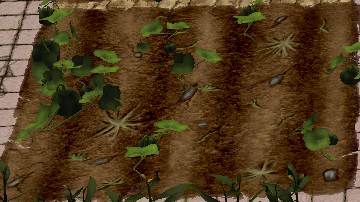
Growth stage two: Autumn Gold, Bushkin, Harvest Moon and Jack-o-Lantern
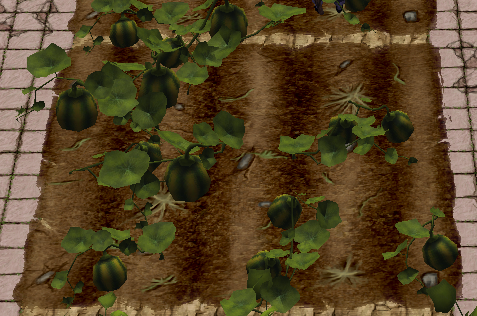
Growth stage three: Aspen, Big Autumn, Connecticut Field and Ghost Rider
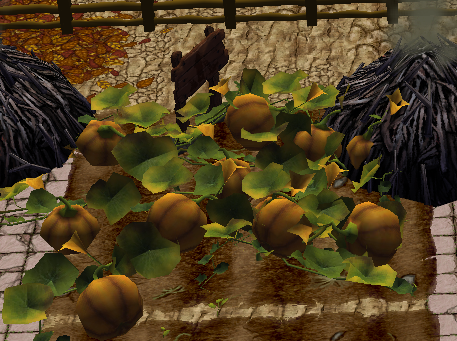
Table of pumpkins at various growth stages:
| Growth Stage | Tier 1 | Tier 2 | Tier 3 | Tier 4 |
|---|---|---|---|---|
| One: | "Baby Bear" | "Small Sugar" | "Sugar Treat" | "Spooktacular" |
| Two: | "Autumn Gold" | "Bushkin" | "Harvest Moon" | "Jack-o-Lantern" |
| Three: | "Aspen" | "Big Autumn" | "Connecticut Field" | "Ghost Rider" |
Spooktacular, Jack-o-Lantern and Ghost Rider are curios. All pumpkins can be sliced for generic pumpkin flesh and seeds.
All pumpkins in growth stage one can be replanted in gardening pots.
Fertilizers & Field Values:
You should fertilize right after you plant as you can no longer fertilize after crops are harvestable.
Each value has a specific effect on the field:
- Upkeep: This reduces the amount of Humus needed to prepare a field as well as reduces the amount of seeds needed to replant the field. The values after calculating for upkeep are base quantity * (Upkeep/100) This value has a bottom cap of 50%. Adding Wood Choppings to the field improves the upkeep by lowering the Upkeep value. Example: a field at 50% Upkeep will require 3 Humus to prepare and 25 Seeds of Grain to plant where as 100% upkeep requires 5 humus and 50 seeds.
- Plenty: This value increases the yield of a field when harvested. Currently, planting a field provides a random amount plenty from 0% to a percentage equal to the planter's Stocks & Cultivars/100. The S&C bonus doesn't effect the fertilizer stacking penalty.
- Speed: This value reduces the growth time of the field. Currently, the field advances one stage every 24 hours and may be harvested after four days after planting. Example: a field at 200% speed should gain a stage of growth every 12 hours (needs testing for verification).
- Influence: This value increases the amount of gain of the four output meters. Boosting this will speed the field to higher tiers of crops faster.
| Fertilizer Type | Upkeep | Plenty | Speed | Influence |
|---|---|---|---|---|
| Hay | - | - | - | ▲(Crop) |
| Wood Choppings | ▽ | - | - | - |
| Lime | - | ▲ | - | - |
| Humus | - | ▲ | - | ▲ |
| Coal | - | - | ▲ | - |
| Clay | - | - | ▽ | ▲ |
| Dross | - | ▽ | ▲ | - |
| Crown Manure | - | ▲ | ▲ | ▲ |
After a field is harvested, all fertilizers are reset and each field loses 5% upkeep. For example, if I keep my field at 50% upkeep each time I plant them, when I replant, they will then lose upkeep value and then be at 55% upkeep.
Finally, the more fertilizers used on a field, the less effective next fertilizer becomes. Each fertilizer counts as one, so a Wood Chopping, a Coal, a Humus, and a Clay counts as four fertilizers, which would be the same reduction as using four Humus. (Note: the exact calculation isn't known.)
Note on cotton: It takes 10 clean cotton to produce a single cotton sheet, this can be achieve by a single field with approximately 200% plenty value.(click image below for larger version)
Seeds:
Seeds for plants are recovered in various ways depending on the plant. As a note, each crop unit provides a maximum number of seeds based on the crop type. That number can be lower and one of them almost always have less than the maximum because.
Grains need to be winnowed for seeds. This is done with the Thresh Cereals command. This destroys the ears of grain, though, so you can either get seed or grind in a windmill for flour.
Cotton seed is included in the boll. In order to get seed, use the Clean Cotton command in the craft menu. This will return a ball of cotton and some seed.
Cabbage produces a seed stalk. When the cabbage field is harvested, you get several heads of cabbage and a seed stalk. Simply place the seed stalk in the container and wait 48 hours for it to dry to collect the seeds.
- When a field is at 100% upkeep the following are required to plant 1 field of a crop:
- 50 seeds of cotton
- 50 seeds of cereal
- 15 seeds of cabbage
- 50 seeds of pumpkin
- When the field is 50% upkeep the following are required:
- 25 seeds of cotton
- 25 seeds of cereal
- 7 seeds of cabbage
- 25 seeds of pumpkin (this seems a bit high, considering pumpkins grow horizontaly and not verticaly like cotton and cereal)
Seeds of Pumpkin can be obtained from any pumpkin by slicing it.
Notes:
I'd like to improve this with screen shots and actual examples. This is going to be one area that may be a challenge.
